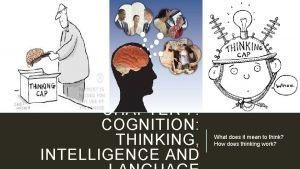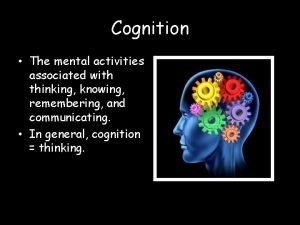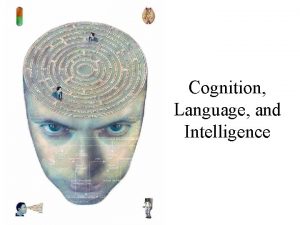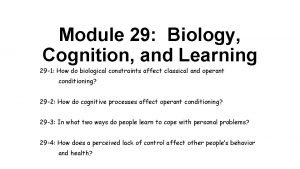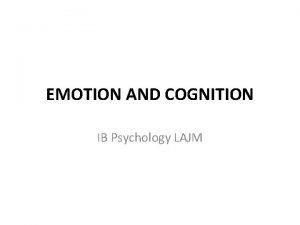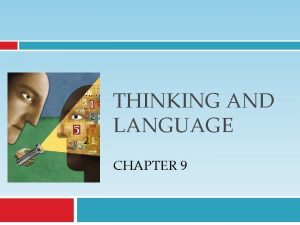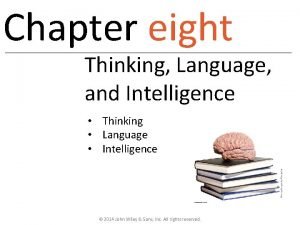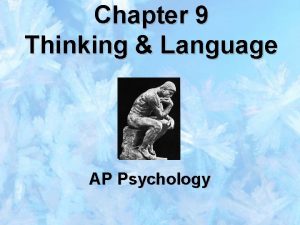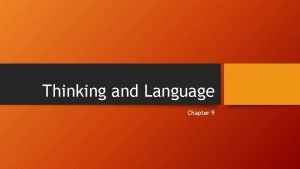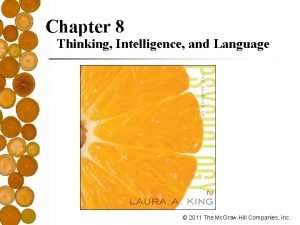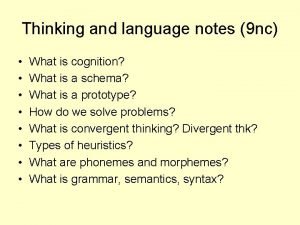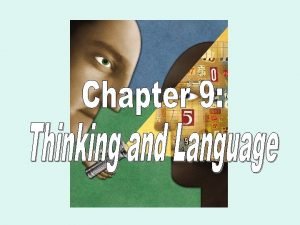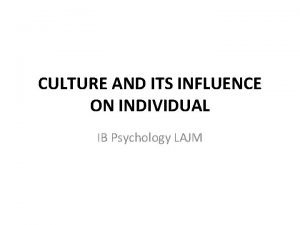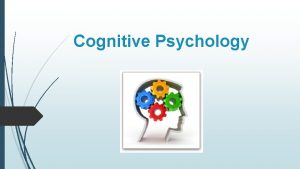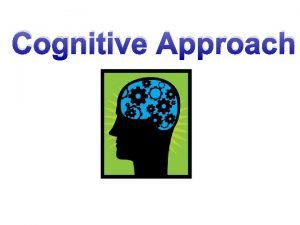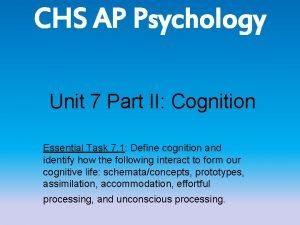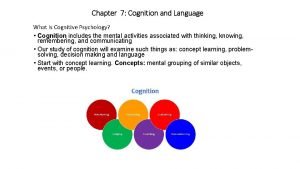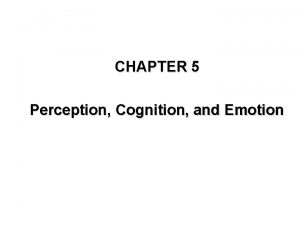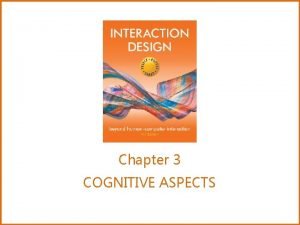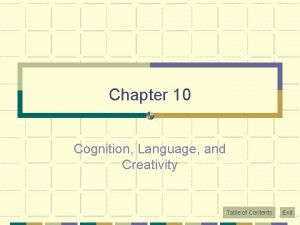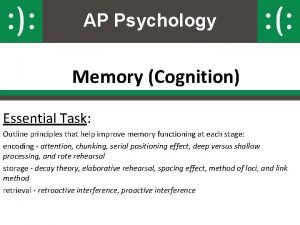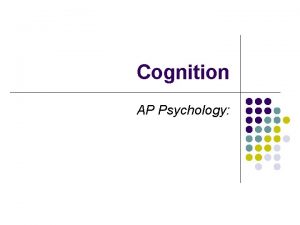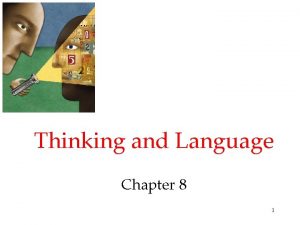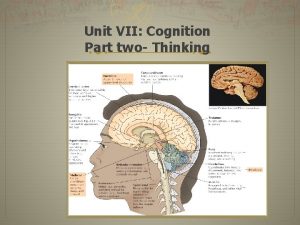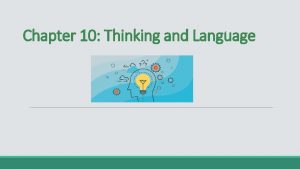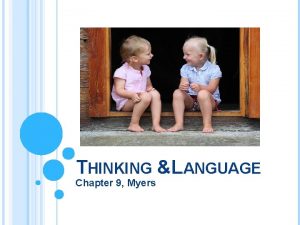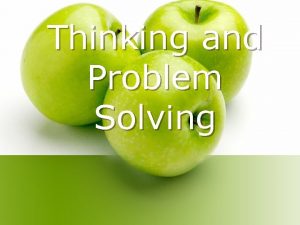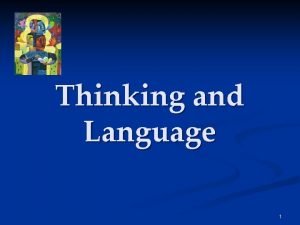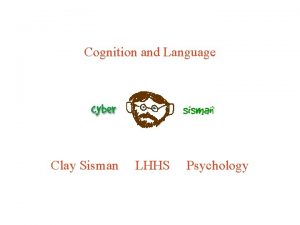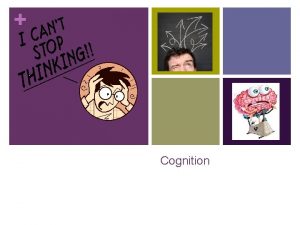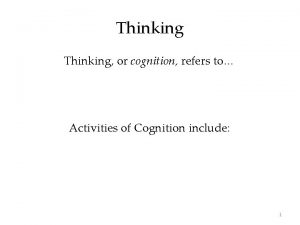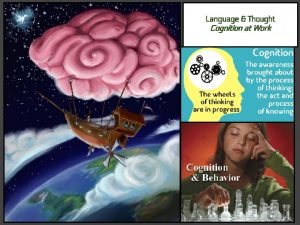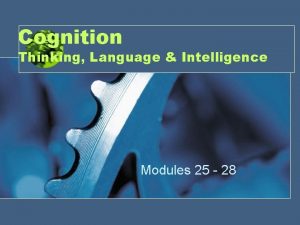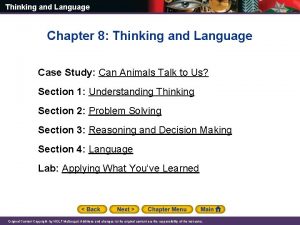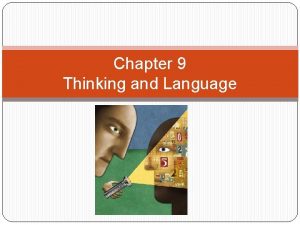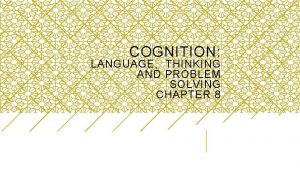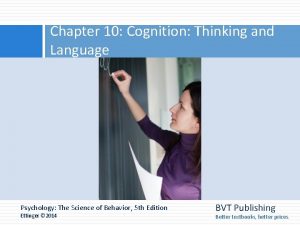Thinking and Language Chapter 9 Thinking Cognition involves





























- Slides: 29

Thinking and Language Chapter 9

Thinking • Cognition involves the mental activities associated with thinking, knowing, remembering, and communicating. • Concepts help to simplify thinking through mental grouping of similar objects, events, ideas, and people. • After placing an item in a category, memory gradually shifts it toward a category prototype. • Categories boundaries begin to blur as movement from prototypes occur.

Thinking • Problem Solving Strategies • An algorithm is a methodical, logical rule or procedure that guarantees a solution to a problem. • A heuristic is a simpler strategy that is usually speedier than an algorithm but is also more error prone. • Insight is not a strategy-based solution, but rather a sudden flash of inspiration that solves a problem.

Thinking • THE Aha! MOMENT • When you come to a sudden realization of something • A burst of right temporal lobe EEG activity is apparent during the aha moment

Thinking • Problem solving obstacles • Confirmation bias predisposes us to verify rather than challenge our hypotheses. • Fixation, such as mental set, may prevent us from taking the fresh perspective that would lead to a solution. • If you need a screwdriver, but don’t have one you can use a dime…. but if you fail to think outside the box and use the dime you are experiencing fixation.

Thinking Forming Good and Bad Decisions and Judgments • Intuition is an effortless, immediate, automatic feeling or thought, as contrasted with explicit, conscious reasoning. • Availability heuristics can distort judgment by estimating event likelihood based on memory availability. • Overconfidence can impact decisions when confidence outweighs correctness.

Thinking Forming Good and Bad Decisions and Judgments • Belief perseverance occurs when we cling to beliefs and ignore evidence that proves these are wrong. • Framing sways decisions and judgments by influencing the way an issue is posed. It can also influence beneficial decisions. Can you think of any such decisions?

Thinking THE FEAR FACTOR—WHY WE FEAR THE WRONG THINGS 1. We fear what our ancestral history has prepared us to fear. 2. We fear what we cannot control. 3. We fear what is immediate. 4. We fear what is most readily available in memory. SCARING US ONTO DEADLY HIGHWAYS In the three months after 9/11, those faulty perceptions led more Americans to travel, and some to die, by car.

Thinking The Perils and Powers of Intuition • Intuition is analysis “frozen into habit. ” • Intuition is implicit knowledge. • Intuition is usually adaptive, enabling quick reactions. • Learned associations surface as “gut” feelings. • Intuition is huge. • Critical thinkers are often guided by intuition.

Thinking • Creativity is the ability to produce new and valuable ideas. • It is supported by • Aptitude or the ability to learn • Intelligence • Working memory

Thinking • Divergent thinking • Expands the number of possible problem solutions (creative thinking that diverges in different directions) • Convergent thinking • Narrows the available problem solutions to determine the single best solution

Thinking • Robert Sternberg and his colleagues propose five ingredients of creativity. • Expertise • Imaginative thinking skills • Venturesome personality • Intrinsic motivation • Creative environment

Thinking • Researchers make inferences about other species’ consciousness and intelligence based on behavior. • Other animals use concepts, numbers, and tools and they transmit learning from one generation to the next. • Other species also show insight, self-awareness, altruism, cooperation, and grief.

Thinking Do Other Species Share Our Cognitive Skills? • Using concepts and numbers • Several species demonstrate ability to sort (e. g. , pigeons and other birds; great apes; humans). • Displaying insight • Humans are not the only species to display insight (e. g. , chimpanzees). • Using tools and transmitting culture • Various species have displayed creative tool use (e. g. , forestdwelling chimpanzees; elephants; humans). Washoe learning sign language

Thinking • Other species display many cognitive skills • Voice-recognition in baboon troops • Mirror self-recognition in great apes and dolphins • Displays of learning, remembering, cooperation in elephants

Language and thought • Language • Involves our spoken, written, or signed words and the ways we combine them to communicate meaning • Is used to transmit civilization’s knowledge from one generation to the next • Connect humans

Language and thought • Three building blocks of spoken language • Phonemes are smallest distinctive sound units in language • Morphemes are smallest language unit that carry meaning. • Grammar is the system of rules that enables humans to communicate with one another. • Semantics: Deriving meaning from sounds • Syntax: Ordering words into sentences

Language and thought • Receptive language: Infant ability to understand what is said to them around 4 months • Production language: Infant ability to produce words begin around 10 months. Month (approx. ) Stage 4 Babbles many speech sounds (“ah-goo”) 10 Babbling resembles household language (“mama”) 12 One - word stage (“Kitty!”) 24 Two - word speech (“Get ball. ”) 24+ Rapid development into complete sentences

Language and thought Babbling stage • Beginning at about 4 months, infant spontaneously utters various sounds at first unrelated to the household language One-word stage • From about age 1 to 2, a child speaks mostly in single words Two-word stage • Beginning about age 2, a child speaks mostly in twoword statements Telegraphic speech • Early speech stage in which a child speaks like a telegram using mostly nouns and verbs.

Language and thinking • Language diversity • 700+ languages worldwide; structurally very different • Chomsky • Argued all languages share basic elements called a universal grammar • Theorized humans are born with predisposition to learn grammar rules; not a built-in specific language

Language and thinking • Critical periods suggest childhood represents critical period for mastering certain aspects of language • People who learn a second language as adults usually speak it with the accent of their native language, and they also have difficulty mastering the new grammar.

Language and thinking • NEW LANGUAGE LEARNING GETS HARDER WITH AGE Young children have a readiness to learn language. Ten years after coming to the United States, Asian immigrants took a grammar test. Those who arrived before age 8 understood American English grammar as well as native speakers • did. Those who arrived later did not. (From Johnson & Newport, 1991. )

Language and thinking Deafness and Language Development • Children born to hearing-nonsigning parents typically do not experience language during early years • Natively Deaf children who learn sign after age 9 do not learn sign language, master basic words, or become as fluent as native signers • Late learners show less right hemisphere brain activity in areas related to sign language reading.

Language and thinking • Cochlear implants or not? • More than 90 percent of all Deaf children are born to hearing parents who often seek cochlear implants for their children. Deaf culture advocates object to this. • National Association of the Deaf argues deafness is not a disability because native signers are not linguistically disabled.

Thinking and language • Damage to any one of several areas of the brain’s cortex can impair language. • Today’s neuroscience has confirmed brain activity in Broca’s and Wernicke’s areas during language processing. • In processing language, the brain operates by dividing its mental functions into smaller tasks. Broca’s area – damage to this area can cause problems speaking Wernicke’s area – damage to this area can cause problems understanding language

Thinking and language Do Other Species Have Language? • Animals display a wide range of comprehension and communication. • Velvet monkeys sound different alarms for different predators. • Chimpanzee (named Washoe) was taught sign language by the Gardners. • Critics noted that ape vocabularies and sentences were simple; vocabulary gained with great difficulties. • Most psychologists agree humans alone possess language.

Thinking and language • Whorf’s linguistic determinism hypothesis: Language determines basic ideas • Evidence from bilingual speakers suggest people think differently in different languages • Bilingual parents often switch language to express emotions • Words influence, but do not determine, thinking

Thinking and language • Expanding language expands ability to think • Bilingual speakers use executive control over language (bilingual advantage) to inhibit attention to irrelevant information • Language connects the past and the future

Thinking and language • After learning a skill, watching the activity activates the brain’s internal stimulation of it (f. MRI research of Calvo. Merino and colleagues, 2004) • Mental rehearsal can aid in academic goal achievement (process stimulation)
 Chapter 7 cognition thinking intelligence and language
Chapter 7 cognition thinking intelligence and language Cognition thinking intelligence and language
Cognition thinking intelligence and language All the mental activities associated with thinking
All the mental activities associated with thinking Iq of blacks
Iq of blacks Module 29 biology cognition and learning
Module 29 biology cognition and learning Teacup ib psychology
Teacup ib psychology Cognition and personalization
Cognition and personalization Dancing the
Dancing the When you group subcategories within broader concepts
When you group subcategories within broader concepts Ap psychology thinking and language
Ap psychology thinking and language Chapter 9 thinking and language notes
Chapter 9 thinking and language notes Evaluating alternatives and making choices among them
Evaluating alternatives and making choices among them Airline reservations typically decline after
Airline reservations typically decline after Definition of telegraphic speech in psychology
Definition of telegraphic speech in psychology Mental.status exam
Mental.status exam Cognition mse
Cognition mse Acculturation studies ib psychology
Acculturation studies ib psychology What is cognition
What is cognition Cognition definition
Cognition definition Embodied cognition ap psychology definition
Embodied cognition ap psychology definition Means end analysis psychology example
Means end analysis psychology example Objectives of perception
Objectives of perception Altered cognition in older adults is commonly attributed to
Altered cognition in older adults is commonly attributed to What is cognition
What is cognition Cognition definition
Cognition definition Priming memory examples
Priming memory examples Ap psychology unit 7
Ap psychology unit 7 Konsep ketersediaan heuristik
Konsep ketersediaan heuristik Embodied cognition ap psychology
Embodied cognition ap psychology Availability heuristic ap psychology
Availability heuristic ap psychology

